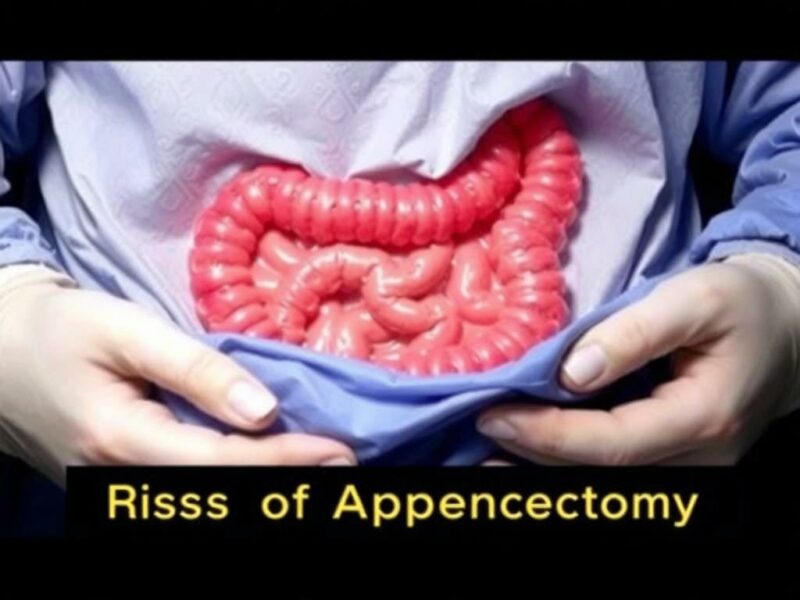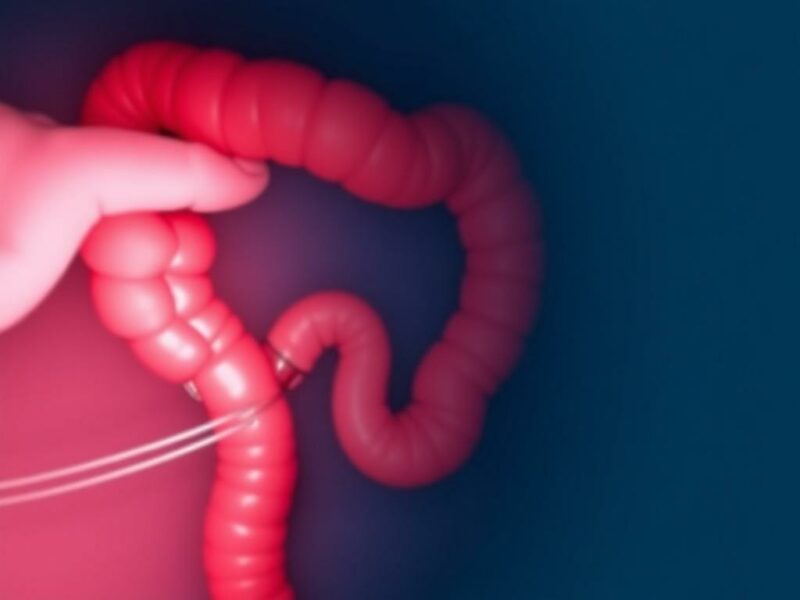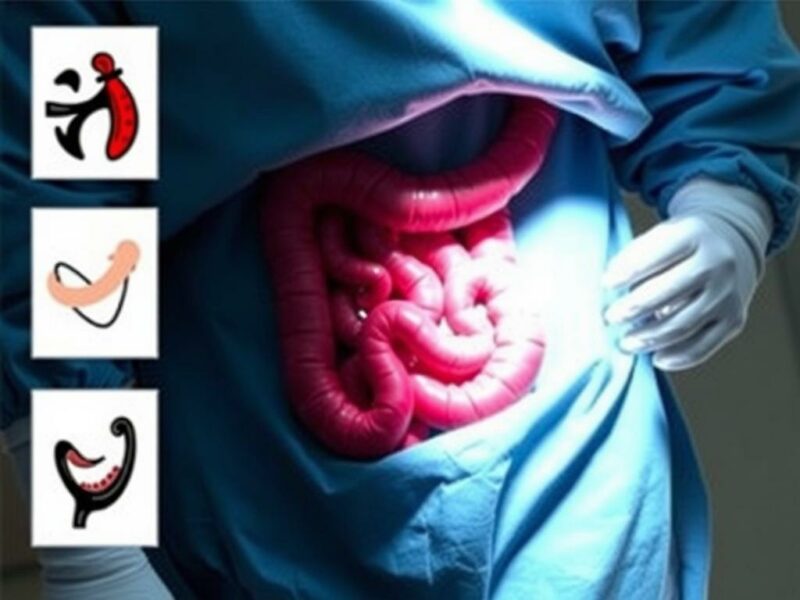An appendectomy is one of the most common surgical procedures worldwide, performed to remove the appendix when it becomes inflamed or infected – a condition known as appendicitis. While this surgery is often lifesaving and tends to be straightforward, like all surgeries, it carries certain risks that patients should be aware of. Understanding these risks helps you prepare mentally and physically, making the recovery process smoother. In this article, we’ll explore the various risks of appendectomy, from common complications to rare but serious concerns, ensuring you’re well-informed whether you’re preparing for or simply curious about the procedure.
What is an Appendectomy and When Is It Performed?
Before diving into the risks of appendectomy, it’s essential to understand what the procedure involves. An appendectomy is the surgical removal of the appendix, a small tube-shaped pouch attached to the large intestine. The most frequent reason for this surgery is appendicitis, where the appendix becomes swollen, infected, and could potentially rupture if not treated promptly.
Doctors usually recommend an appendectomy when symptoms like abdominal pain, nausea, vomiting, and fever point to appendicitis. The surgery can be performed either as an open appendectomy, involving a small incision in the lower right abdomen, or laparoscopically, which uses small incisions and a camera to guide the removal.
Why Understanding the Risks of Appendectomy Matters
Surgery can be daunting, and knowing the possible risks helps reduce anxiety and prepare patients for the journey. While appendectomies are generally safe and have high success rates, they are not risk-free. Risks can vary depending on factors like the patient’s age, overall health, the severity of appendicitis, and the surgical method used. By understanding potential complications, you’ll be better positioned to recognize warning signs, follow postoperative care instructions diligently, and engage in productive conversations with your healthcare provider.
Common Risks Associated with Appendectomy
Most patients undergoing appendectomy experience smooth recoveries without significant issues. Here are some of the more common risks or side effects that might arise during or after the surgery:
- Infection: Even with sterile techniques, surgical wounds can develop infections, especially if the appendix ruptured before removal.
- Bleeding: Slight bleeding during or after surgery is common, but significant blood loss is rare.
- Pain and Discomfort: Post-surgical pain is expected but typically manageable with medication.
- Swelling or Inflammation: Localized swelling around the incision area can occur during healing.
- Digestive Changes: Some patients may experience temporary diarrhea or constipation after the procedure.
Less Common But More Serious Risks
While less frequent, there are more serious risks of appendectomy that require immediate medical attention:
- Bowel Obstruction: Scar tissue or adhesions can cause blockage in the intestines.
- Damage to Nearby Organs: During surgery, there’s a small chance of injury to organs like the intestines, bladder, or blood vessels.
- Abscess Formation: A collection of pus may develop if infection persists after surgery.
- Deep Vein Thrombosis (DVT): Blood clots in the legs can occur after surgery due to decreased mobility.
Risks Specific to Laparoscopic vs. Open Appendectomy
Different surgical techniques come with their own risk profiles:
| Risk Type | Laparoscopic Appendectomy | Open Appendectomy |
|---|---|---|
| Infection Risk | Lower risk of wound infection | Higher risk due to larger incision |
| Recovery Time | Generally shorter with faster return to normal activities | Longer recovery due to a bigger incision |
| Internal Organ Injury | Higher risk due to limited tactile feedback | Lower risk because of direct visualization |
| Bowel Obstruction | Lower incidence of adhesions causing obstruction | Higher incidence due to scar tissue |
Factors That Can Increase the Risks of Appendectomy
Several patient-specific factors can influence the likelihood or severity of risks:
Delayed Treatment or Ruptured Appendix
When appendicitis is left untreated for too long, the appendix may rupture, spilling infectious materials into the abdominal cavity. This scenario increases the risk of postoperative infections, abscesses, and complications such as peritonitis, a life-threatening inflammation of the abdominal lining.
Underlying Health Conditions
Patients with chronic medical conditions such as diabetes, heart disease, or immune system disorders may face increased risks. For example, diabetes can slow wound healing, increasing the chance of infection. Similarly, compromised immune function may reduce the body’s ability to fight off infections post-surgery.
Age and Physical Condition
Very young children and elderly patients typically have higher risk during surgery. Older adults may face more challenges during recovery due to weaker physical resilience and potential comorbidities. Also, obesity can increase surgical risks by complicating anesthesia and wound healing.
Medication and Allergies
Certain medications, especially blood thinners, can raise the risk of bleeding during surgery. Allergies to anesthesia or antibiotics used during the procedure may also cause complications.
Signs of Complications After Appendectomy
Being vigilant about postoperative symptoms is crucial to catch potential complications early. If you or a loved one has undergone an appendectomy, watch for the following signs:
- Fever above 101°F (38.3°C) that persists or worsens
- Increased pain, redness, swelling, or discharge around the incision site
- Persistent nausea or vomiting
- Difficulty urinating or severe abdominal swelling
- Shortness of breath or leg swelling, which could indicate blood clots
- Sudden sharp abdominal pain signaling possible bowel obstruction
Reporting these symptoms to your healthcare provider as soon as possible can prevent minor issues from becoming life-threatening complications.
How to Minimize the Risks of Appendectomy
While some risks are unavoidable, there are several steps patients and medical teams can take to reduce complications:
Early Diagnosis and Treatment
Seeking early medical attention at the first signs of appendicitis—such as persistent abdominal pain or fever—can reduce the chances of rupture and severe infection.
Choosing the Right Surgical Approach
Discuss with your surgeon whether laparoscopic or open appendectomy is more suitable, considering your health background and the severity of appendicitis.
Preoperative Preparation
Inform your healthcare team about all medications and allergies, and follow pre-surgery instructions carefully, such as fasting or medication adjustments.
Postoperative Care and Follow-Up
Following wound care instructions, taking prescribed antibiotics, moving as recommended, and attending follow-up appointments are essential to ensure smooth healing.
Healthy Lifestyle and Nutrition
A balanced diet, staying hydrated, and avoiding smoking can all help support your body’s recovery after surgery.
Appendectomy Risks in Children and Elderly Patients
Special attention is required when it comes to children and seniors because their bodies respond differently to surgery.
Appendectomy Risks in Children
Kids generally recover faster, but they may have difficulty communicating pain or discomfort. Complications like wound infections can occur if the postoperative care environment lacks proper hygiene. Pediatric appendicitis can also sometimes present atypically, leading to delayed diagnosis, increasing risk.
Appendectomy Risks in Elderly
Older adults often have slower recoveries. They are at higher risk for respiratory complications due to anesthesia and immobility. Additionally, pre-existing health conditions can elevate chances of postoperative infection or cardiac issues. Careful monitoring after the procedure is vital.
Long-Term Risks and Considerations After Appendectomy

After the initial recovery phase, some patients may experience longer-term consequences, though these are relatively uncommon.
Adhesions and Chronic Pain
Scar tissue can develop inside the abdomen, sometimes causing adhesions that lead to chronic abdominal pain or bowel obstruction months or years after surgery.
Hernia at the Incision Site
Especially after open appendectomy, there is a small risk that the abdominal wall might weaken, resulting in a hernia.
Altered Digestive Function
While the appendix is not essential for survival, some studies suggest it may play a role in gut immunity. However, most people experience no digestive issues post-appendectomy.
Risks of Appendectomy vs. Risks of Untreated Appendicitis
Understanding the risks of appendectomy often raises the question: “What if I avoid surgery?” Untreated appendicitis can be far more dangerous. The appendix can rupture and spread infection throughout the abdomen, leading to peritonitis, sepsis, and even death. In contrast, the surgical risks, while present, tend to be manageable with modern medical care.
Comparison Table: Appendectomy Risks vs. Untreated Appendicitis Risks
| Risk Factor | Risks of Appendectomy | Risks of Untreated Appendicitis |
|---|---|---|
| Infection | Possible wound infection or abscess | High risk of widespread peritonitis |
| Mortality | Very low with modern surgery | Significant if ruptured appendix untreated |
| Pain | Post-surgical pain | Increasing severe pain if untreated |
| Recovery Time | Usually days to weeks | Potentially fatal without treatment |
Frequently Asked Questions About Appendectomy Risks
Is an appendectomy a dangerous surgery?
Not typically. Appendectomy is a routine surgery with a high success rate. Risks exist, but serious complications are uncommon in healthy individuals.
How long does it take to recover from an appendectomy?
Recovery can range from one to three weeks for laparoscopic procedures and a bit longer for open surgery.
Can the appendix grow back after removal?
No, once removed, the appendix does not regenerate.
What can I do to prevent infections after surgery?
Follow wound care instructions, keep the incision clean and dry, and take all prescribed medications.
Is it possible to avoid surgery if diagnosed early?
Some mild cases might be managed with antibiotics, but surgery remains the definitive treatment, especially if there is high risk of rupture.
Emerging Techniques to Reduce Risks in Appendectomy

Advancements in surgical techniques and technology continue to improve safety profiles. Robot-assisted appendectomy offers enhanced precision, reducing the chance of damage to surrounding tissues. Additionally, improved anesthesia protocols and postoperative pain management help reduce complications like blood clots and respiratory issues.
The Psychological Impact of Appendectomy
While most focus on the physical risks of appendectomy, psychological factors can also influence recovery. Anxiety before surgery, fear of complications, or pain-related stress can affect healing. Support from healthcare providers, family, and possibly counseling can help patients cope better during the perioperative period.
Summary Table: Key Risk Factors and Recommendations
| Risk Factor | Description | Recommended Action |
|---|---|---|
| Infection | Surgical site or abdominal infection | Maintain hygiene, take antibiotics, monitor symptoms |
| Bleeding | Excessive blood loss during/after surgery | Avoid blood-thinners pre-surgery, alert doctor if bleeding occurs |
| Bowel Obstruction | Blockage caused by internal scar tissue | Report abdominal pain or vomiting promptly |
| Blood Clots (DVT) | Clots formed due to reduced mobility | Early mobilization, compression stockings |
| Organ Injury | Damage to surrounding organs | Choose experienced surgeon, monitor post-op symptoms |
| Delayed Treatment | Waiting too long increases complications | Seek immediate medical care with appendicitis symptoms |
Final Thoughts on the Risks of Appendectomy

Appendectomy is a widely performed and generally safe procedure that plays a crucial role in managing appendicitis and preventing its dangerous consequences. While understanding the risks of appendectomy is important, it’s vital to remember that the benefits of removing an inflamed or infected appendix almost always outweigh these risks. Close collaboration with healthcare providers, good preoperative and postoperative care, and prompt attention to any concerning symptoms can help minimize complications and ensure a smooth recovery. If you or someone you know is facing appendectomy, empowering yourself with knowledge about what to expect and how to mitigate risks will make the experience far less daunting and far more manageable. Ultimately, the goal is to get you back on your feet healthy, safe, and ready to enjoy life again.



